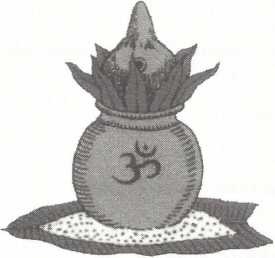By Swami Harshananda
Ghaṭa literally means ‘a pot'.
A ghaṭa or a mud-pot is an important accessory in many religious rituals.
Significance[edit]
As a Kumbha[edit]
When ghaṭa is filled with water and decorated with certain leaves and coconut, it becomes fit for any deity for being ceremonially invoked into it. Such a ghaṭa is also called as a kumbha or a kalaśa. It is one of the four receptacles of divinity. The other three are the:
As a Motif in Temples[edit]
It is sometimes used as an art motif which indicates auspiciousness and abundance. It is found on the pillars and doors in temples.
[edit]
A ceremonially installed pot is an essential part of the worship of the Mother Durgā during this festival.
As per Haṭhayoga[edit]
According to the works on Haṭhayoga, ghaṭa or ghaṭāvasthā is a state of prāṇāyāma. In this state, the two prāṇas or vital airs are in a balanced state which leads to the union of the jīva (individual soul) with Paramātman (the Supreme Soul). These two vital airs are:
In Philosophy[edit]
According to the philosophical treatises, the word ‘ghaṭa’ is sometimes used to indicate the body. It indicates the body as fragile as a mudpot.
References[edit]
- The Concise Encyclopedia of Hinduism, Swami Harshananda, Ram Krishna Math, Bangalore

